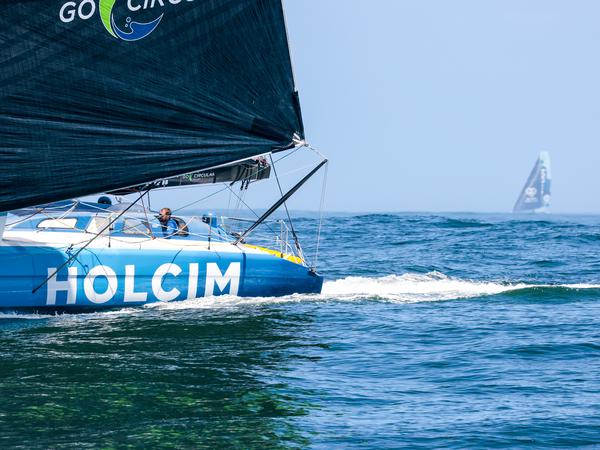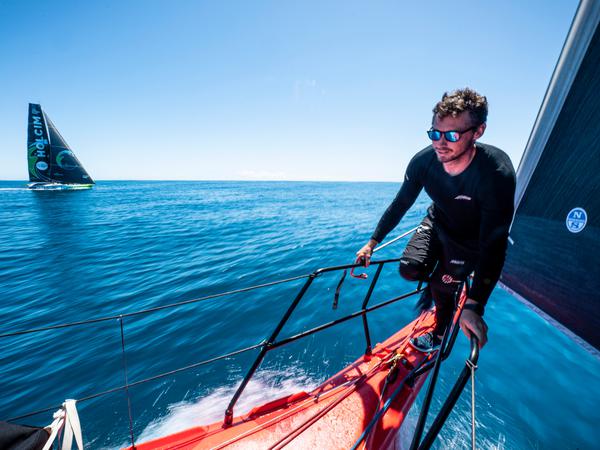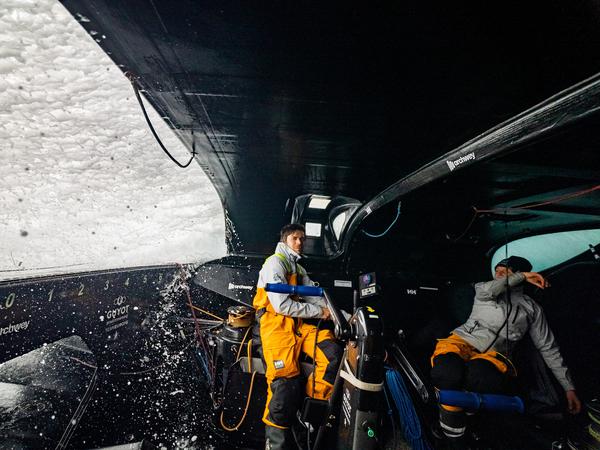“Honestly,” Sam Goodchild says afterwards, “we just got a little lucky.” With a wafer-thin lead of 16 minutes, “Holcim-PRB” secured victory in the second stage of the Ocean Race from Cape Verde to Cape Town after 4000 miles. And the British co-skipper knew it wasn’t skill that made him lucky. “In any case, I’m not going to go and claim that we won because we had the talent.”
It just wasn’t predictable enough for that. On the one hand, the winds developed completely differently than expected, on the other hand, another of the four teams fighting for the lead repeatedly pushed their way to the top. “But we were ahead in the end.”

The second to cross the finish line was the French “Biotherm” team around skipper Paul Meilhat, who had lost touch with the leading group a week earlier. The Americans from “11th Hour” arrived in Cape Town third, nine minutes later.
Skipper Charlie Enright and navigator Simon Fisher had been in front for long stretches of the stage and hardly did anything wrong. They engaged in hand-to-hand combat for thousands of miles with “Holcim-PRB”, stalking each other, forcing their opponents to follow them. Only when land was already in sight and the wind dropped again did the French Escoffier and Meilhat position themselves tactically better. They were also able to sail more depth, so the tide turned in favor of the other two a few miles from the finish.
The golden rule doesn’t always apply
“You just don’t understand part of this game, which is why a bit of luck is also part of it,” says Tom Laperche from the “Holcim” crew after the triumph.

The finale was a bit similar to the start of the stage. Because she had started under similarly windless conditions. Instead of a full trade wind, which normally flows through Cape Verde, there was a gentle breeze. And for the “Malizians”, who had to sail on without Boris Herrmann after a burn injury, it was a revenge that they hadn’t packed a spinnaker for such conditions. The others sat down.
At times the gap was 230 miles. It was not until they were approaching the Kalmen that navigator and strategist Nicolas Lunven unlocked the German boat again. He heeded the golden rule best, according to which the transition through the windless equatorial zone should be sought as far west as possible, where it is weakest.

But “Guyot Environment” with skipper Robert Stanjek and the French navigator Sebastièn Simon managed a completely different feat. Knowing their ship’s somewhat aged constitution and clumsiness, they had sought their luck far to the east, where the route is shorter, but usually more difficult to find due to the thermal labyrinth of rain clouds, squalls and wind holes. Whatever Simon deduced from the weather data turned out to be correct. Within a few days, the Franco-German team had covered a hundred miles and taken the lead.
Things might have gone well if Guyot’s easterly route hadn’t gotten too close to the center of the St. Helena High, which has been particularly prominent in the southern hemisphere these days. The team with the oldest ship got stuck in the doldrums, while the four teams positioned further west passed.
Lost the thread in the wind hole off Cape Town
The winner of this phase of the race was the “Malizia”. Skipper Will Harris had covered the longest distance, but took advantage of the stronger wind. After two weeks at sea she was in the lead and best positioned for the final sprint to Cape Town.
But being ahead can also be a curse when there’s nothing ahead but doldrums. And so it was that “Malizia” gave up his leadership position in search of more wind, veered south and got on the defensive. The course line for the last 50 miles records 11 maneuvers, while Botherm and 11th Hour required six and Holcim four.
“Guyot” didn’t even need one anymore. When Stanjek, Simon, Phillip Kasüske and Anne-Clair le Berre crossed the finish line a little under three hours after the winner, they had reduced a large deficit with a furious final sprint.
After this finish, the ranking is sorted more clearly:
- “Holcim PRB”, 10 points
- “11th Hour, 7
- “Biotherm”, 6
- “Malizia”, 5
- “Guyot”, 2
The next stage will lead from Cape Town across the Southern Ocean to Itajai in Brazil. Because of the extraordinary length of the route and the special challenge that the region presents to boats and crews, there is a double point classification. For Boris Herrmann, who will join the “Malizia” crew again in Cape Town and watched the arrival of “his” ship from a dinghy, it will now be seen whether his boat concept will work. The “Malizia” has not yet proven to be slow. But the harsh conditions of the southern Indian Ocean are what she was built for.
To home page
